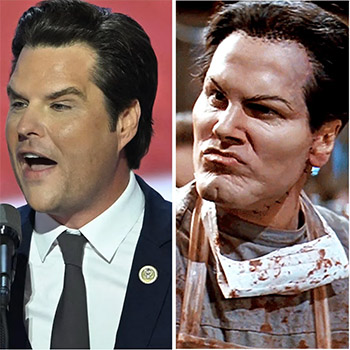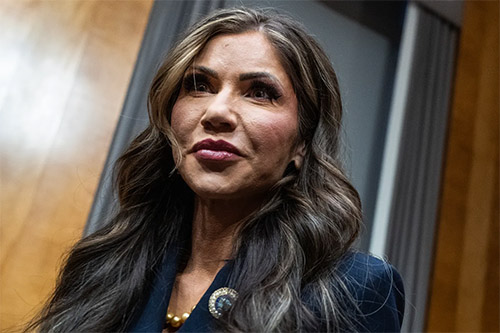https://ia800109.us.archive.org/34/item ... 3.17.0.pdf
James Baltzer (SBN 332232)
[email protected]
[email protected]
Attorneys for Plaintiffs
[Additional Counsel on signature page]
UNITED STATES DISTRICT COURT
FOR THE NORTHERN DISTRICT OF CALIFORNIA
SAN FRANCISCO DIVISION
AMERICAN FEDERATION OF GOVERNMENT EMPLOYEES, AFL-CIO; AMERICAN FEDERATION OF STATE COUNTY AND MUNICIPAL EMPLOYEES, AFLCIO; AFGE LOCAL 1216; UNITED NURSES ASSOCIATIONS OF CALIFORNIA/UNION OF HEALTH CARE PROFESSIONALS, AFSCME, AFL-CIO; AFGE LOCAL 2110; MAIN STREET ALLIANCE; COALITION TO PROTECT AMERICA’S NATIONAL PARKS; WESTERN WATERSHEDS PROJECT; VOTE VETS ACTION FUND INC.; and COMMON DEFENSE CIVIC ENGAGEMENT, Plaintiffs,
v.
UNITED STATES OFFICE OF PERSONNEL MANAGEMENT and CHARLES EZELL, in his official capacity as Acting Director of the U.S. Office of Personnel Management,
Defendants.
Case No. 3:25-cv-01780-WHA [William Haskell Alsup]
Highlights:
“Plaintiffs”), file this complaint seeking to enjoin the terminations of tens of thousands of federal employees in contravention of federal constitutional and statutory law, against Defendants the United States Office of Personnel Management (“OPM”) and Acting OPM Director Charles Ezell…
On February 13, 2025, Defendant OPM and its newly appointed Acting Director, Defendant Charles Ezell, ordered federal agencies across the country to terminate tens of thousands of federal employees by sending them standardized notices of termination, drafted by OPM, that falsely state that the terminations are for performance reasons….
Probationary employees may include experienced federal employees who have recently become employed in a new position or a new agency....
OPM’s directive…on pretextual grounds, seeks to further the newly elected Presidential Administration’s policy goals…But Congress, not OPM, controls and authorizes federal employment and related spending by the federal administrative agencies, and Congress has determined that each agency is responsible for managing its own employees. OPM lacks the constitutional, statutory, or regulatory authority to order federal agencies to terminate employees in this fashion that Congress has authorized those agencies to hire and manage, and certainly has no authority to require agencies to perpetrate a massive fraud on the federal workforce by lying about federal workers’ “performance,” to detriment of those workers, their families, and all those in the public and private sectors who rely upon those workers for important services….
Notwithstanding this lack of legal authority, OPM ordered federal agencies throughout the nation, including in this District, to wipe out their ranks of probationary employees…
OPM also ordered the agencies to use a template e-mail to terminate these workers, provided by OPM, that falsely inform employees that their terminations are for performance reasons…
The federal agencies that followed OPM’s directive did not otherwise have plans to terminate the entirety of their probationary workforce…some agencies have confirmed to their employees that they did not want to terminate their probationary employees but were directed to do so by OPM. And they have confirmed that the notices of termination mandated by OPM were false, because the agencies were not firing the workers for performance reasons….
tens of thousands of probationary employees across dozens of federal agencies have already been terminated in the summary, assembly-line fashion directed by OPM. Each day, more such employees receive notice of the termination of their federal employment. The terminations have been conducted summarily, without any advance notice to the affected employees, throwing their lives, their families’ lives, and the entire federal government into chaos….
OPM, the federal agency charged with implementing this nation’s employment laws, in one fell swoop has perpetrated one of the most massive employment frauds in the history of this country, telling tens of thousands of workers that they are being fired for performance reasons, when they most certainly were not….
OPM’s program is an unlawful ultra vires action outside the scope of any statutory or Constitutional authority. OPM’s program also violates the APA’s prohibitions of unlawful, arbitrary and capricious, and procedurally improper agency action (including because this government-wide action was taken without notice and comment rule-making). Where, as here, a federal agency has engaged in unlawful action contrary to the APA, the courts “shall …hold unlawful and set aside” that action….
The APA, was designed to “serve as the fundamental charter of the administrative state.”… “Congress in 1946 enacted the APA ‘as a check upon administrators whose zeal might otherwise have carried them to excesses not contemplated in legislation creating their offices.’”… OPM’s actions disrupt the constitutional balance of power and violate numerous federal statutes, running roughshod over fundamental protections against unlawful and arbitrary federal action….
Each agency has its own authorizing statutes that govern its administration, including statutory provisions that authorize one or more individuals to act as the head of the agency….
Congress has also authorized, in these agency-specific establishing statutes, each agency head to exercise powers of management over that agency and its employees, including the hiring and firing of employees…
Congress also delegated general authority to each federal agency head to adopt regulations “for the government of his department, the conduct of its employees, the distribution and performance of its business…”…
Congress also enacted the Civil Service Reform Act of 1978 (“CSRA”) to establish uniform standards for agencies and civil service employment across the federal government….(defining “civil service”)… (defining “employee”)…
Congress also established the OPM by statute…Congress did not authorize the OPM to hire or fire any federal employees employed by any agency other than OPM itself…OPM’s role, as established by Congress, is to act as the human resources agency for the federal government, including by creating and publishing government-wide rules in compliance with the APA…OPM’s authority with respect to the termination of employees of other agencies and departments is limited to providing technical assistance and writing regulations….
OPM’s mass termination program has swept up two categories of federal employees, whose employment is governed by statute and regulation: probationary employees in the “competitive” service, and employees within their first two years of employment in the “excepted” service….
Federal agencies may lawfully terminate probationary employees based on the agency’s assessment of the employee’s performance during the probationary period, pursuant to 5 C.F.R. § 315.804(a), which is entitled: “Termination of probationers for unsatisfactory performance or conduct.”…
“[W]hen an agency decides to terminate an employee serving a probationary or trial period because his work performance or conduct during this period fails to demonstrate his fitness or his qualifications for continued employment, it shall terminate his services by notifying him in writing as to why he is being separated and the effective date of the action.”… “The information in the notice as to why the employee is being terminated shall, as a minimum, consist of the agency’s conclusions as to the inadequacies of his performance or conduct.”…
Federal agencies may also lawfully terminate a probationary employee “for reasons based in whole or in part in conditions arising before his appointment.”…
Federal agencies may also terminate probationary employees as part of an agency RIF. An agency may conduct a RIF “to reduce the size of its workforce.”… “RIFs are not aimed at removing particular individuals; rather, they are directed solely at positions.”…
Agencies must follow specific statutory directives in conducting a RIF, including detailed requirements for retention preferences, considerations for veterans, and the consideration of tenure of employment and length of service….Congress delegated to OPM the authority to promulgate regulations that agencies must follow in implementing RIFs….
These RIF regulations apply whenever an agency determines that it is necessary to release employees “because of lack of work; shortage of funds; insufficient personnel ceiling; reorganization; the exercise of reemployment rights or restoration rights; or reclassification of an employee’s position due to erosion of duties … .”…
All agencies of the federal government are required to comply with the RIF regulations whenever an agency “determines that a reduction force is necessary.”…
The RIF regulations apply to employees in the competitive and excepted services….Probationary employees are expressly protected by the RIF regulations….Probationary employees are included in “group II” of three groups of employees, and may only be released, in order of retention, after the release of “group III” employees, a group that includes employees under various temporary, term, and other provisional appointments….
Many probationary employees are veterans or would otherwise be entitled to preference in the event of a RIF….
The RIF regulations require that employees receive notice of at least 60 days before being released from employment, or at least 30 days from when the RIF is caused by circumstances that were not reasonably foreseeable….
The governing statute and the RIF regulations also require that states and local governments be notified in advance of RIFs of 50 or more employees in an affected geographic area so they can be prepared to assist affected employees….
Before the first day of the new Presidential Administration, OPM had never taken the position that it had the authority to direct other agencies to terminate employees….No mention was made of any federal government plan to terminate the employment of probationary employees at any agency, or across the nation….
No union or group of federal employees had been provided any notice of any program or decision to terminate probationary employees….
[ B]efore January 20, 2025, OPM had no plans to order federal agencies to terminate their probationary employees, and no agency had such a plan….
Before January 20, 2025, no OPM Director had ever taken the position that OPM had the legal authority to direct agencies to terminate the employment of employees of other federal agencies….
On January 20, 2025, the first day of the incoming Presidential Administration…
Acting OPM Director Ezell distributed a memo to “Heads and Acting Heads of Departments and Agencies” regarding “Guidance on Probationary Periods, Administrative Leave and Details.” In this memo, Acting Director Ezell directed department and agency heads to submit to OPM, no later than January 24, 2025 [(4) four days], a report listing all “employees on probationary periods, who have served less than a year in a competitive service appointment, or who have served less than two years in an excepted service appointment.” The memorandum directed agencies to “promptly determine whether these employees should be retained at the agency.”…
OPM required agencies to adhere to a 200-character limit in any explanation provided as to why any individual employee should be retained by the agency….
On February 11, 2025, President Trump issued Executive Order 14210, entitled “Implementing the President’s ‘Department of Government Efficiency’ Workforce Optimization Initiative.” The Executive Order instructed that “Agency Heads shall promptly undertake preparations to initiate large-scale reductions in force (RIFs).”…
OPM did not wait for agencies to plan for or initiate any RIF….
On February 13, 2025, OPM officials met with agency leaders across the federal government and directed them to begin firing their probationary employees without following RIF procedures….
Agencies across the federal government began acting on OPM’s February 13 directive immediately through chaotic mass terminations of their probationary employees….
Tens of thousands of probationary employees have already been subjected to mass terminations, with no advance notice, by agencies across the federal government…
“So for those of you that have federal benefits. Sorry. Okay. For those of you that have federal benefits, your health insurance will be terminated at the end of the pay period.… This is not a decision the agency made. This is a direction we received…We are following orders. We are part of the executive branch. ….There’s no negotiation, first of all….It is only a matter of time. It is not today is not the only workforce reduction that we will do.”…
The NSF explained that the agency had previously been told that it would have discretion to retain workers, and had in fact made the decision to retain all of its probationary employees, only to have OPM issue a superseding order on February 13, 2025 requiring the agency to terminate everyone:…
“And late, late Friday night….They told us that they directed us to remove probationers.”….
Termination letters received by probationary employees in multiple agencies, including the Departments of Homeland Security, Health and Human Services, Agriculture, and Education, included identical introductory language…with identical footnotes….
Termination letters received by probationary employees in multiple agencies included the following boilerplate language describing the reasons for their termination: “The Agency finds, based on your performance, that you have not demonstrated that your further employment at the Agency would be in the public interest.”… “Unfortunately, the Agency finds that that you are not fit for continued employment because your ability, knowledge and skills do not fit the Agency’s current needs, and your performance has not been adequate to justify further employment at the Agency.”…
Despite the citation of these authorities in the template termination letters, the letters fail to provide any individualized reasons why the employees’ performance warranted termination. Many termination letters appear to have been created by means of mail merges. Some termination letters do not even specify the name of the employee being terminated….
The reference to employee performance in the mass termination letters and the citation to the authority for the termination of probationary employees for performance reasons is a pretext. The real reason for the mass terminations, as expressed by the incoming Presidential Administration, is to reduce the size of the federal workforce….
Many terminated probationary employees had received excellent performance reviews from their agencies. Supervisors were not consulted as to the performance of individual probationary employees before they were terminated…. some probationary employees have subsequently been told by agency representatives that they were terminated solely because their agencies were being restructured…“most of those employees were rated as being ‘exceptional’ performers by their supervisors.”…
Terminated employees and their families now face an immediate loss of income and benefits (including health benefits); economic insecurity; the immediate need to search for alternative employment; and the future adverse impact of an employment termination falsely predicated on performance….
“the Trump administration has already made the United States more exposed to catastrophic wildfires in ways that will be difficult to reverse, current and former federal employees say….The job cuts, which amount to roughly 10 percent of the agency’s work force, could hobble the Forest Service, which was already struggling to remove vegetation across its vast land holdings at a pace that matches the growing threat from fires…
On February 22, 2025, OPM began to implement a new mandatory reporting program for all federal employees throughout the federal government. OPM has ordered all federal employees to submit e-mail reports justifying their work….
Prior to February 22, 2025, federal employees were not required to submit any reports regarding their work to OPM. On information and belief, no OPM rule, regulation, policy, or program has ever, in United States history, purported to require all federal workers to submit reports to OPM….
The message was not signed by any government official, nor did it identify the head of agency on whose behalf it was sent, the authority or program under which it was sent….
The title of the email was: “What did you do last week?”…
On February 22, 2025 a social media account purporting to belong to an individual named Elon Musk (@elonmusk), who has been identified by the President as the head of the federal agency known as Department of Government Efficiency (“DOGE”), posted the following message: “Consistent with President @realDonaldTrump’s instructions, all federal employees will shortly receive an email requesting to understand what they got done last week. Failure to respond will be taken as a resignation.”…
Prior to February 22, 2025, no notice was published, in the Federal Register or anywhere else, regarding any OPM program, rule, policy, or regulation requiring all federal employees to provide a report regarding their work to OPM….
OPM has not complied with any procedural requirements in the APA, 5 U.S.C. §553, with respect to this new program….some federal agencies, including the Federal Bureau of Investigation, began telling their employees not to respond to this OPM surprise request….
The Constitution vests the legislative power in Congress….
The Constitution vests executive power in the President…. [and] a duty to “take Care that the Laws be faithfully executed.”…
The President and Executive Branch have no constitutional power to unilaterally enact, amend, or repeal parts of duly enacted statutes….The declared purpose of separating and dividing the powers of government was to “diffus[e] power the better to secure liberty.”… James Madison in The Federalist No. 47, [said] that ‘there can be no liberty where the legislative and executive powers are united in the same person, or body of magistrates’....”…
Congress exercised its Article I legislative authority to create the agencies of the federal government….To the agency heads, Congress has also expressly delegated the power to manage the functions of the agencies, including the right to employ and discharge subordinate employees of the agencies and to spend appropriated funds on those positions….
Congress has also generally authorized the heads of administrative agencies to make employment decisions…
Congress also made the federal administrative agencies subject to the requirements of the CSRA, which sets forth uniform rules pertaining to employment for the civil service across federal agencies. The agencies, led by their agency heads, are obligated by Congress to comply with the CSRA with respect to their employees….
The OPM Program requiring federal agencies to remove probationary employees throughout the federal government unlawfully usurps the legislative authority of Congress and is therefore ultra vires…
OPM’s actions were not authorized by any Article II Executive power, because no Article II constitutional power authorizes OPM to order federal agencies created by Congress to discharge subordinate agency employees, or to direct agencies to rely on false statements regarding employee performance to effectuate the discharged ordered by OPM….
Under the APA, a court shall “hold unlawful and set aside agency action” that is “arbitrary, capricious, an abuse of discretion, or otherwise not in accordance with law”…
The actions of OPM and its Acting Director, including but not limited to the OPM program requiring federal agencies to terminate probationary employees, violate the Administrative Procedure Act because they are inconsistent with law in violation of 5 U.S.C. § 706(2)(A), and exceed statutory authority, in violation of 5 U.S.C. § 706(2)(C), and are for those reasons also arbitrary and capricious in violation of 5 U.S.C. § 706(2)(A)….
OPM’s actions are based on the fiction that the employees are being terminated for performance reasons; OPM’s actions are intended to deprive terminated employees of an administrative remedy; OPM’s actions required agencies to terminate employees immediately, often with only a few hours notice; OPM’s actions required agencies to violate commitments made to employees and the agency’s own plans for those employees; and OPM’s actions had no relationship to agencies’ staffing needs or statutory mandates….
The OPM Order directing agencies to terminate probationary employees is a “rule” for purposes of the APA….
Notwithstanding the OPM Director’s express obligations pursuant to 5 U.S.C. §§ 1103 and 1105 to comply with notice and comment rule-making pursuant to the APA, neither OPM nor its Acting Director complied with the rule-making provisions set forth in 5 U.S.C. § 553 before issuing the OPM order directing agencies to terminate probationary employees….
Had OPM followed notice-and-comment procedures required by the APA, Plaintiffs would have provided comments about the OPM Program….
OPM’s new program for federal employee reporting constitutes final agency action under the APA….
Plaintiffs pray that this Court:
1. Declare that OPM’s new programs 1) requiring federal agencies to terminate probationary employees and 2) requiring federal employees to report to OPM are unlawful;
2. Enter preliminary or permanent injunctive relief setting aside OPM’s order as unlawful; requiring Defendants, and all persons acting in concert with them, to cease terminations of probationary employees pursuant to OPM’s program and order; and requiring Defendants, and all persons acting in concert with them, to rescind the prior unlawful terminations of probationary employees pursuant to OPM’s Order.
3. Enter preliminary or permanent injunctive relief setting aside OPM’s order as unlawful; requiring Defendants, and all persons acting in concert with them, to cease requiring federal employees to report to OPM, and take no action against any employee who fails to respond to OPM’s instructions to report...
FIRST AMENDED COMPLAINT FOR DECLARATORY AND INJUNCTIVE RELIEF
Plaintiffs American Federation of Government Employees, AFL-CIO (“AFGE”), American Federation of State County and Municipal Employees, AFL-CIO (“AFSCME”), AFGE Local 1216, and United Nurses Associations of California/Union of Health Care Professionals, AFSCME, AFLCIO (“UNAC/UHCP”), AFGE Local 2110 (collectively, “Union Plaintiffs”), Main Street Alliance, Coalition To Protect America’s National Parks, Western Watersheds Project, Vote Vets Action Fund Inc., and Common Defense Civic Engagement (collectively, “Plaintiffs”), file this complaint seeking to enjoin the terminations of tens of thousands of federal employees in contravention of federal constitutional and statutory law, against Defendants the United States Office of Personnel Management (“OPM”) and Acting OPM Director Charles Ezell, and hereby plead as follows:
INTRODUCTION
1. On February 13, 2025, Defendant OPM and its newly appointed Acting Director, Defendant Charles Ezell, ordered federal agencies across the country to terminate tens of thousands of federal employees by sending them standardized notices of termination, drafted by OPM, that falsely state that the terminations are for performance reasons.
2. Probationary employees are employees of the competitive service in their first year of employment, and employees of the excepted service in their first two years of employment (hereafter collectively “probationary employees”). Probationary employees may include experienced federal employees who have recently become employed in a new position or a new agency.
3. OPM’s directive that federal agencies terminate these employees en masse, on pretextual grounds, seeks to further the newly elected Presidential Administration’s policy goals of dramatically curtailing the size and spending of the federal government. But Congress, not OPM, controls and authorizes federal employment and related spending by the federal administrative agencies, and Congress has determined that each agency is responsible for managing its own employees. OPM lacks the constitutional, statutory, or regulatory authority to order federal agencies to terminate employees in this fashion that Congress has authorized those agencies to hire and manage, and certainly has no authority to require agencies to perpetrate a massive fraud on the federal workforce by lying about federal workers’ “performance,” to detriment of those workers, their families, and all those in the public and private sectors who rely upon those workers for important services.
4. OPM is an agency with no statutory authority to make termination decisions for federal employees (other than for OPM’s own employees). Notwithstanding this lack of legal authority, OPM ordered federal agencies throughout the nation, including in this District, to wipe out their ranks of probationary employees without any regard to applicable statutes, including the Administrative Procedure Act (“APA”) and statutes governing federal employment and the respective roles of OPM and the agencies.
5. OPM also ordered the agencies to use a template e-mail to terminate these workers, provided by OPM, that falsely inform employees that their terminations are for performance reasons rather than as part of a government-wide policy to reduce headcount that was authorized by no law.
6. The federal agencies that followed OPM’s directive did not otherwise have plans to terminate the entirety of their probationary workforce, who were employed in authorized positions to perform services that in each agency’s judgment were needed to perform their statutorily mandated role. In fact, some agencies have confirmed to their employees that they did not want to terminate their probationary employees but were directed to do so by OPM. And they have confirmed that the notices of termination mandated by OPM were false, because the agencies were not firing the workers for performance reasons.
7. As of the filing of this Complaint, tens of thousands of probationary employees across dozens of federal agencies have already been terminated in the summary, assembly-line fashion directed by OPM. Each day, more such employees receive notice of the termination of their federal employment. The terminations have been conducted summarily, without any advance notice to the affected employees, throwing their lives, their families’ lives, and the entire federal government into chaos.
8. OPM, the federal agency charged with implementing this nation’s employment laws, in one fell swoop has perpetrated one of the most massive employment frauds in the history of this country, telling tens of thousands of workers that they are being fired for performance reasons, when they most certainly were not.
9. OPM’s program is an unlawful ultra vires action outside the scope of any statutory or Constitutional authority. OPM’s program also violates the APA’s prohibitions of unlawful, arbitrary and capricious, and procedurally improper agency action (including because this government-wide action was taken without notice and comment rule-making). Where, as here, a federal agency has engaged in unlawful action contrary to the APA, the courts “shall …hold unlawful and set aside” that action. 5 U.S.C. § 702(2).
10. The APA, was designed to “serve as the fundamental charter of the administrative state.” Kisor v. Wilkie, 588 U.S. 558, 580 (2019) (plurality opinion) (internal quotation marks omitted). As the Supreme Court recently explained, “Congress in 1946 enacted the APA ‘as a check upon administrators whose zeal might otherwise have carried them to excesses not contemplated in legislation creating their offices.’” Loper Bright Enterprises v. Raimondo, 603 U.S. 369, 391 (2024) (quoting United States v. Morton Salt Co., 338 U.S. 632, 644 (1950)). OPM’s actions disrupt the constitutional balance of power and violate numerous federal statutes, running roughshod over fundamental protections against unlawful and arbitrary federal action.
11. The Court should immediately enjoin OPM and all those acting in concert with it to cease implementation of its unlawful order requiring these mass pretextual terminations of probationary federal employees and to rescind the unlawful terminations that already have occurred.
JURISDICTION AND VENUE
12. This Court has jurisdiction pursuant to 28 U.S.C. § 1331.
13. Venue is appropriate in this district under 28 U.S.C. § 1391(e). Plaintiffs AFGE and AFGE Local 1216 represent probationary and trial-period federal employees whose place of employment is within the Northern District of California, and who have been terminated, or are subject to termination, because of OPM’s illegal program.
14. Intradistrict assignment is appropriate in the San Francisco/Oakland division of this Court.
PARTIES
15. Plaintiff AFGE, AFL-CIO, is a labor organization and unincorporated association headquartered at 80 F Street N.W., Washington, D.C. 20001. AFGE, the largest union of federal employees, represents approximately 800,000 federal civilian employees through its affiliated councils and locals in every state in the United States, including employees of numerous agencies of the federal government, including the Department of Veterans Affairs (“VA”), Department of Education, National Institutes of Health, Small Business Administration, and others. AFGE represents employees of the VA who are employed in San Francisco, Oakland, San Bruno, Eureka, Ukiah, Clearlake, and Martinez, California.
16. Plaintiff AFSCME, AFL-CIO, is a labor organization and unincorporated association headquartered at 1625 L Street, N.W., Washington, D.C. 20036. AFSCME is the largest trade union of public employees in the United States, with 1.4 million members organized into approximately 3,400 local unions, 58 councils and affiliates in 46 states, the District of Columbia and Puerto Rico. AFSCME unions represent federal civilian employees in numerous agencies and departments across the federal government, including the Federal Aviation Administration, the Department of Agriculture, the Peace Corps, Americorps, and the Veterans Administration.
17. Plaintiff AFGE Local 1216 is a labor organization and unincorporated association headquartered at 4150 Clement Street, San Francisco, California 94121. AFGE Local 1216 represents hundreds of VA employees who are employed in San Francisco, California.
18. Plaintiff United Nurses Association of California/United Health Care Professionals, AFSCME, AFL-CIO (“UNAC”), is a labor organization and an unincorporated association headquartered at 955 Overland Ct., Suite 150, San Dimas, California 91773. UNAC represents employees of the VA who are employed at Pettis Memorial Hospital in Loma Linda, California.
19. Plaintiff AFGE Local 2110 is a labor organization and unincorporated association headquartered in Palo Alto, California. AFGE Local 2110 represents approximately 4,000 employees of the VA at the VA Palo Alto Health Care System, including its Menlo Park and Livermore Divisions, and at several Community-Based Outpatient Clinics in Fremont, San Jose, Monterey, and Capitola. Those employees work in all non-supervisory classifications, including doctors, nurses, emergency medical services personnel, food service workers, custodial staff, and administrative staff.
20. Plaintiff Main Street Alliance (“MSA”) is a national network of small businesses, with approximately 30,000 members throughout the United States. MSA helps small business owners realize their full potential as leaders for a just future that prioritizes good jobs, equity, and community through organizing, research, and policy advocacy. MSA also seeks to amplify the voices of its small business membership by sharing their experiences with the aim of creating an economy where all small business owners have an equal opportunity to succeed. MSA is nonpartisan and is a §501(c)(3) organization. MSA has approximately 1,410 small business members in California, including more than 70 small businesses in Alameda, Santa Clara, San Francisco, Sonoma, and Contra Costa Counties.
21. Plaintiff Coalition to Protect America’s National Parks (“Coalition”) is a non-profit organization made up of over 3,400 members, all of whom are current, former, and retired employees and volunteers of the National Park Service. Together, they have accumulated over 50,000 years of experience caring for America’s most valuable natural and cultural resources. The Coalition’s goal is to support the preservation and protection of the National Park System and the mission-related programs of the National Park Service (“NPS”) to ensure the survival of the park system for generations to come. The Coalition’s members are regular and avid users of the National Park System and NPS programs.
22. Plaintiff Western Watersheds Project (“WWP”) is a non-profit environmental conservation group that works to influence and improve public lands management throughout the western United States to protect native species and conserve and restore the habitats they depend on. WWP’s primary focus is on the negative impacts of livestock grazing, including harm to ecological, biological, cultural, historic, archeological, scenic resources, wilderness values, roadless areas, Wilderness Study Areas and designated Wilderness. WWP was founded in 1993 and has more than 14,000 members and supporters and field offices in Idaho, Montana, Wyoming, Arizona, Nevada, and Oregon. WWP covers over 250 million acres of public land spanning all of the western states.
23. Plaintiff Vote Vets Action Fund Inc. (“VoteVets”) is a non-partisan, non-profit organization incorporated under the laws of the District of Columbia. Its purpose is to lift up the voices of veterans on matters of national security, veterans’ care, and everyday issues that affect the lives of those who served as well as their families including foreign policy, veterans’ unemployment, robust investment in care for veterans, energy security, protecting the rights of those who serve, and upholding the Constitution and democracy that every military member swore to uphold and protect. VoteVets has nearly two million supporters across the country, in all fifty states, with whom it regularly communicates about issues affecting veterans, including the operations, programs, and services available through the VA. Approximately 417,000 of VoteVets’ supporters live in California, including 131,000 in Northern California.
24. Plaintiff Common Defense Civic Engagement (“Common Defense”) is a grassroots membership organization of progressive veterans, military families, and civilian supporters standing up for our communities against the rising tide of racism, hate, and violence. Common Defense invests in the leadership of its members through training and deployment in campaigns that connect directly to their history of service, including voting rights, climate justice, and anti-militarism. Approximately 33,187 of Common Defense’s members live in California, including approximately 2,000 veterans.
25. Plaintiffs bring the claims in this complaint on their own behalf and on behalf of their members.
26. Defendant Office of Personnel Management (“OPM”) is a federal agency headquartered in Washington, D.C. OPM is a federal agency within the meaning of the Administrative Procedure Act (“APA”), 5 U.S.C. § 551(1).
27. Defendant Charles Ezell has been the Acting Director of OPM since January 20, 2025. He is sued in his official capacity.
FACTUAL ALLEGATIONS
I. Statutes and Regulations Governing Termination of Federal Employment
A. Congressional Authorization to Federal Agencies and OPM
28. Congress created the federal agencies that employ federal workers through an exercise of its Article I legislative power. The executive agencies of the federal government are identified in various statutes, including 5 U.S.C. § 101 (listing agencies).
29. Each agency has its own authorizing statutes that govern its administration, including statutory provisions that authorize one or more individuals to act as the head of the agency. See e.g.,10 U.S.C. §§ 111, 113 (Defense); 12 U.S.C. § 5491 (CFPB); 16 U.S.C. § 551 (Agriculture/Forest Service); 26 U.S.C. §§ 7801, 7803 (IRS); 38 U.S.C. §§ 301, 303 (VA); 42 U.S.C. §§ 202, 203 (HHS); 42 U.S.C §§ 281, 282 (NIH); 42 U.S.C. §§3411, 3412 (Education); 42 U.S.C. § 7131 (Energy); 51 U.S.C. § 20111 (NASA).
30. Congress has also authorized, in these agency-specific establishing statutes, each agency head to exercise powers of management over that agency and its employees, including the hiring and firing of employees, consistent with any generally applicable laws. For example:
• 26 U.S.C. §§ 7803, 7804 (IRS: “the Commissioner of Internal Revenue is authorized to employ such number of persons as the Commissioner deems proper for the administration and enforcement of the internal revenue laws, and the Commissioner shall issue all necessary directions, instructions, orders, and rules applicable to such persons.”);
• 42 U.S.C. §§ 7231, 7253 (Energy: “In the performance of his functions the Secretary is authorized to appoint and fix the compensation of such officers and employees, including attorneys, as may be necessary to carry out such functions. Except as otherwise provided in this section, such officers and employees shall be appointed in accordance with the civil service laws …”; the Secretary is authorized to establish, alter, consolidate or discontinue such organizational units or components within the Department as he may deem to be necessary or appropriate.”);
• 20 U.S.C. § 3461 (Education: “The Secretary is authorized to appoint and fix the compensation of such officers and employees, including attorneys, as may be necessary to carry out the functions of the Secretary and the Department. Except as otherwise provided by law, such officers and employees shall be appointed in accordance with the civil service laws …”);
• 42 U.S.C. § 203 (HHS: “The Secretary is authorized … to establish within them such divisions, sections, and other units as he may find necessary; and from time to time abolish, transfer, and consolidate divisions, sections, and other units and assign their functions and personnel in such manner as he may find necessary for efficient operation of the Service.”);
• 12 U.S.C. § 5492 (CFPB: “The Bureau is authorized to establish the general policies of the Bureau with respect to all executive and administrative functions, including—…(7) the appointment and supervision of personnel employed by the Bureau; (8) the distribution of business among personnel appointed and supervised by the Director and among administrative units of the Bureau”);
• See also, e.g., 16 U.S.C. §§ 551, 554a, e (Agriculture; management and employment in Forest Service); 38 U.S.C. §§ 303, 510 (VA: Secretary; “control, direction, and management of Department”; “authority to reorganize offices”); 10 U.S. C. § 113 (DOD: Secretary; “authority, direction, and control over the Department of Defense”); 42 U.S.C. § 282 (NIH: Director, management authority); 51 U.S.C. §§ 20111, 20113 (NASA: Administrator “shall have authority and control over all personnel and activities thereof.”).
31. In addition to the specific authority granted to each agency head by these authorizing statutes, Congress also enacted a “General authority to employ” that applies to all federal agencies:
Each Executive agency, military department, and the government of the District of Columbia may employ such number of employees of the various classes recognized by chapter 51 of this title as Congress may appropriate for from year to year.
5 U.S.C. § 3101.
32. Besides this specific authority regarding employment decisions, Congress also delegated general authority to each federal agency head to adopt regulations “for the government of his department, the conduct of its employees, the distribution and performance of its business…” 5 U.S.C. § 301; see also 5 U.S.C. § 302 (authorizing agency heads to delegate their authority to subordinate employees).
33. Congress also enacted the Civil Service Reform Act of 1978 (“CSRA”) to establish uniform standards for agencies and civil service employment across the federal government. 5 U.S.C. § 2101 (defining “civil service”); § 2015 (defining “employee”). The provisions of the CSRA include statutes governing agency termination of employees for cause based on performance (5 U.S.C. § 4303(a); 5 U.S.C. § 7513(a)), and agency layoffs (“reductions in force, or “RIFs”) (5 U.S.C. § 3502).
34. Congress also established the OPM by statute. 5 U.S.C. § 1101. Congress did not authorize the OPM to hire or fire any federal employees employed by any agency other than OPM itself. 5 U.S.C. §§ 1102, 1103. Rather, OPM’s role, as established by Congress, is to act as the human resources agency for the federal government, including by creating and publishing government-wide rules in compliance with the APA. 5 U.S.C. §§ 1103, 1105. OPM’s authority with respect to the termination of employees of other agencies and departments is limited to providing technical assistance and writing regulations. 5 U.S.C. §§ 4304, 4305, 7514.
35. As the Acting Solicitor General recently confirmed in a petition to the U.S. Supreme Court on behalf of the President and other federal officials, “[a]gency heads control hiring and firing decisions for subordinates—here, an agency of over 100 people who perform important investigative and enforcement functions affecting the entire federal workforce.” Thus, in support of its request to vacate a district court temporary restraining order reinstating the head of the Office of Special Counsel, the federal government argued that the President’s inability to remove the head of the agency deprived him of the power to control agency’s employees—because only the agency head is authorized to hire and fire an agency’s employees.1
Probationary and Trial-Period Employees in Federal Service
36. Approximately 200,000 probationary employees are employed in agencies throughout the federal government nationwide.2 Of these, approximately 15,000 are employed in California, providing services that range from fire prevention to veterans’ care.
37. OPM’s mass termination program has swept up two categories of federal employees, whose employment is governed by statute and regulation: probationary employees in the “competitive” service, and employees within their first two years of employment in the “excepted” service. Plaintiffs refer herein to all such employees as “probationary employees.”
38. Probationary employees in the competitive service are, with some exceptions, those who have been employed for less than one year. 5 U.S.C. § 7511(a)(1)(A)(ii); 5 C.F.R. § 315.801. Employees are appointed as “career” or “career-conditional employees” subject to completing the probationary period. 5 C.F.R. § 315.201(a).
39. The probationary period provides the opportunity for the federal agency to assess the individual performance of the employee. Under governing OPM regulations, an agency “shall utilize the probationary period as fully as possible to determine the fitness of the employee and shall terminate his or her services during this period if the employee fails to demonstrate fully his or her qualifications for continued employment.” 5 C.F.R. § 315.803(a).
40. Most employees in the excepted service are also subject to a statutory trial period of two years, which, like the probationary period in the competitive service, is intended to permit the agency to evaluate the employee’s performance and fitness for long-term employment. 5 U.S.C. § 7511(a)(1)(C)(ii).
C. Regulations Governing the Termination of Probationary Employees
41. Federal agencies may lawfully terminate probationary employees based on the agency’s assessment of the employee’s performance during the probationary period, pursuant to 5 C.F.R. § 315.804(a), which is entitled: “Termination of probationers for unsatisfactory performance or conduct.”
42. Under that regulation, “when an agency decides to terminate an employee serving a probationary or trial period because his work performance or conduct during this period fails to demonstrate his fitness or his qualifications for continued employment, it shall terminate his services by notifying him in writing as to why he is being separated and the effective date of the action.” 5 C.F.R. § 315.804(a). “The information in the notice as to why the employee is being terminated shall, as a minimum, consist of the agency’s conclusions as to the inadequacies of his performance or conduct.” Id. Trial-period employees in the excepted service have the same notice rights when removed from their positions for performance reasons. 5 C.F.R. § 316.304.
43. Federal agencies may also lawfully terminate a probationary employee “for reasons based in whole or in part in conditions arising before his appointment.” 5 C.F.R. § 515.805.
D. Statutes and Regulations Governing the Termination of Employees as Part of a RIF [Reduction in Force]
44. Federal agencies may also terminate probationary employees as part of an agency RIF. An agency may conduct a RIF “to reduce the size of its workforce.” Tiltti v. Weise, 155 F.3d 596, 601 (2d Cir. 1998). “RIFs are not aimed at removing particular individuals; rather, they are directed solely at positions.” Grier v. Dep’t of Health & Hum. Servs., 750 F.2d 944, 945 (Fed. Cir. 1984).
45. Agencies must follow specific statutory directives in conducting a RIF, including detailed requirements for retention preferences, considerations for veterans, and the consideration of tenure of employment and length of service. 5 U.S.C. § 3502(a)(1), (3). Congress delegated to OPM the authority to promulgate regulations that agencies must follow in implementing RIFs. 5 U.S.C. § 3502(a).
46. Pursuant to that statutory authorization, and through notice-and-comment rulemaking, OPM has issued detailed regulations setting forth the procedures by which RIFs must be conducted. See 5 C.F.R. Part 351. These RIF regulations apply whenever an agency determines that it is necessary to release employees “because of lack of work; shortage of funds; insufficient personnel ceiling; reorganization; the exercise of reemployment rights or restoration rights; or reclassification of an employee’s position due to erosion of duties … .” 5 C.F.R. § 351.201(a)(2).
47. All agencies of the federal government are required to comply with the RIF regulations whenever an agency “determines that a reduction force is necessary.” 5 C.F.R. § 351.204; see also 5 C.F.R. § 351.201(c) (“Each agency is responsible for assuring that the provisions in this part are uniformly and consistently applied in any one reduction in force.”).
48. The RIF regulations apply to employees in the competitive and excepted services. 5 C.F.R. § 351.202(a), (b). Probationary employees are expressly protected by the RIF regulations. 5 C.F.R. §§ 351.501(b)(2), 351.502(b)(2). Probationary employees are included in “group II” of three groups of employees, and may only be released, in order of retention, after the release of “group III” employees, a group that includes employees under various temporary, term, and other provisional appointments. 5 C.F.R. § 351.501(b).
49. Before conducting a RIF, a federal agency must establish “competitive areas in which employees compete for retention.” 5 C.F.R. § 351.402. Thus, RIFs are not conducted based on agency-wide seniority. Many probationary employees are veterans or would otherwise be entitled to preference in the event of a RIF.
50. The RIF regulations require that employees receive notice of at least 60 days before being released from employment, or at least 30 days from when the RIF is caused by circumstances that were not reasonably foreseeable. 5 C.F.R. § 351.801(a), (b).
51. The governing statute and the RIF regulations also require that states and local governments be notified in advance of RIFs of 50 or more employees in an affected geographic area so they can be prepared to assist affected employees. 5 U.S.C. § 3502; 5 C.F.R. § 351.803.
II. OPM’s Unlawful February 13, 2025 Order to Fire Probationary Employees Across the Nation
52. Before the first day of the new Presidential Administration, OPM had never taken the position that it had the authority to direct other agencies to terminate employees. As of early January 2025, the Acting OPM Director was Rob Shriver. On January 16, 2025, he issued a press release, and gave an interview discussing OPM’s work with agencies throughout the federal government on issues ranging from “skills-based federal hiring”; the “”retirement claims backlog”; a “new health insurance program for Postal workers”; and, significantly, “how agencies recruit and retain early-career employees.” (Emphasis added).3 No mention was made of any federal government plan to terminate the employment of probationary employees at any agency, or across the nation.
53. Before January 20, 2025, OPM had made no public statement regarding any program to terminate probationary employees. Neither had any agency in the federal government made any public statement regarding any desire to terminate probationary employees. No union or group of federal employees had been provided any notice of any program or decision to terminate probationary employees. On information and belief, before January 20, 2025, OPM had no plans to order federal agencies to terminate their probationary employees, and no agency had such a plan.
54. Before January 20, 2025, no OPM Director had ever taken the position that OPM had the legal authority to direct agencies to terminate the employment of employees of other federal agencies.
55. On January 20, 2025, the first day of the incoming Presidential Administration, President Donald J. Trump appointed Charles Ezell to serve as Acting OPM Director.
56. The same day, Acting OPM Director Ezell distributed a memo to “Heads and Acting Heads of Departments and Agencies” regarding “Guidance on Probationary Periods, Administrative Leave and Details.” In this memo, Acting Director Ezell directed department and agency heads to submit to OPM, no later than January 24, 2025 [(4) four days], a report listing all “employees on probationary periods, who have served less than a year in a competitive service appointment, or who have served less than two years in an excepted service appointment.”4 The memorandum directed agencies to “promptly determine whether these employees should be retained at the agency.”5
57. OPM required agencies to adhere to a 200-character limit in any explanation provided as to why any individual employee should be retained by the agency.6
58. On February 11, 2025, President Trump issued Executive Order 14210, entitled “Implementing the President’s ‘Department of Government Efficiency’ Workforce Optimization Initiative.”7 The Executive Order instructed that “Agency Heads shall promptly undertake preparations to initiate large-scale reductions in force (RIFs).”8
59. OPM did not wait for agencies to plan for or initiate any RIF.
60. On February 13, 2025, OPM officials met with agency leaders across the federal government and directed them to begin firing their probationary employees without following RIF procedures.9















